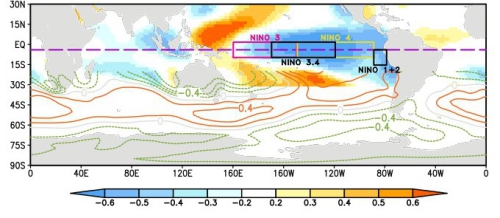Antarctic Atmospheric Circulation Influences Tropical Pacific Sea Surface Temperature
Date:2018-01-04
In the tropical Pacific the most remarkable phenomenon is the periodic occurrence of warm and cold states of sea surface temperature (SST), referred to as El Ni?o–Southern Oscillation (ENSO). The warm and cold phases of ENSO are El Ni?o and La Ni?a, respectively. Despite overwhelming consensus in the literature regarding the fundamental role of tropical air–sea interactions in determining the characteristics of ENSO, there is growing evidence for the role of extratropical forcings too.
In the extratropics of the Southern Hemisphere, the air masses at middle and high latitudes usually exhibit an out-of-phase relationship. This “seesaw” phenomenon is called the Southern Hemisphere Annular Mode (SAM), or Antarctic Oscillation, and is the most important feature of atmospheric circulation around the Antarctic.
Dr. ZHENG Fei from the Institute of Atmospheric Physics, Chinese Academy of Sciences, and her coauthors, found that the December–January–February SAM may influence March–April–May tropical Pacific SSTs. A positive SAM leads to cooler SST anomalies in the central Pacific, whereas a negative SAM leads to warmer SST anomalies. These SST anomalies caused by the SAM overlay those caused by ENSO, and thus change the amplitude of ENSO.

Tropical ENSO signal (shading) and extratropical SAM signal (contours). A possible influence of the SAM on ENSO has been found recently.
The results shed additional light on the extratropical forcings of ENSO. The study was recently published in Advanced in Atmospheric Sciences.
Reference
Zheng, F., J. P. Li, and R. Q. Ding, 2017: Influence of the preceding austral summer Southern Hemisphere annular mode on the amplitude of ENSO decay. Adv. Atmos. Sci., 34(11), 1358–1379. https://doi.org/10.1007/s00376-017-6339-4
